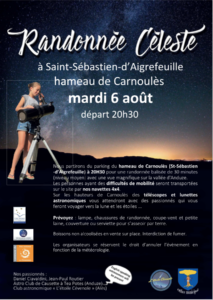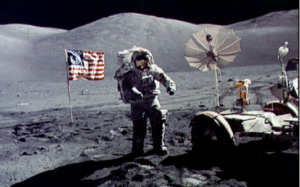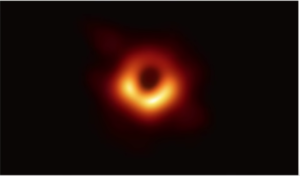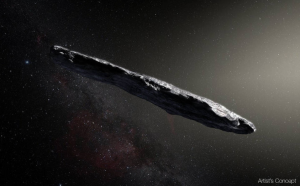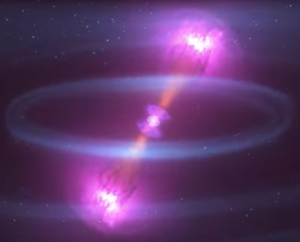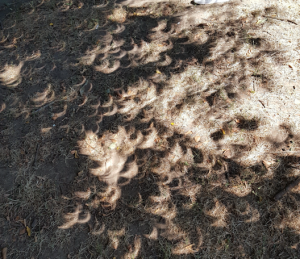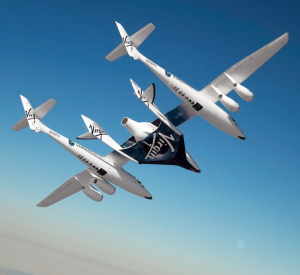Minutes of Meeting 11th March 2022 at Saint-Seb
We had 7 attendees: Aline, David Miles, Carole and Chris Fogg, Steve Hills and Monica and Martin,
Proposed program: 1 Voyager probes Mission Status (Carole)
2. Ephemeris: do you like the current form of “fridge notes” ie. is the addition of Planet ephemera appreciated ?
3, Algol, the Devil Star MY
4. James Webb Space (IR) telescope and will it see evidence of “The Big Bang” ? The telescope is parked at L:agrange point , L2 Heliocentric orbit at distance of ~ 1 million miles from Earth: no going back to adjust (like Hubble) !!
5 The Cosmic Web Simulated computer program (“how can they photograph that ?
6 Watch “LANIAKEA” YouTube questions / discussion
7. Allow 30 minutes for Another Point of View: ‘there was no Big Bang” Dissertation by MY
Meeting closed about 12.30, no decision taken about next meeting. Martin Y
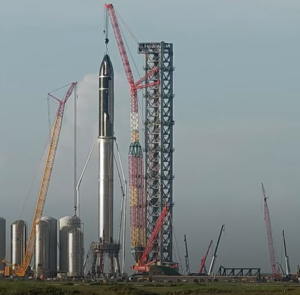 Click on pic Another Historic Picture.
Click on pic Another Historic Picture.
Click on pic for clarity.
Saint Seb: View from la mairie, This is a proposed replacement for “TeaPotes”
Photographed 18th June 2021: just before relaxation of Covid rules,
LAST MEETING Oct 9th at LE RANC : SEE UNDER HEADING MINUTES
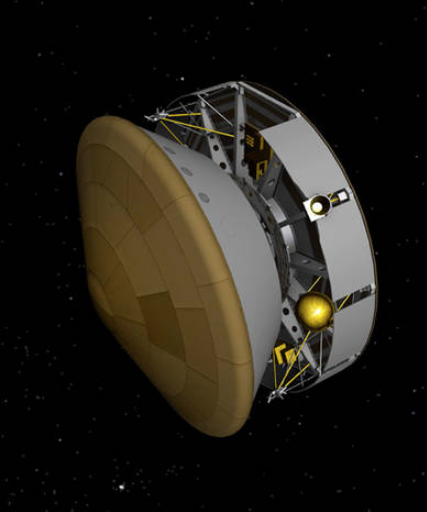
SEE MINUTES OF LAST MEETING 11th SEPTEMBER CHEZ YOUNG
We will follow our discussion with general space news, including updates on Moon and Mars missions (thanks Michael Cowell – Planetary Society). I attach a picture of Perseverance Rover on its way to Mars (landing date Feb 18th 2021). The landing site of this Mars rover is Jezero Crater – a 28-mile-wide crater on the western rim of Isidis Planitia, a giant impact basin just north of the Martian equator. The crater was a possible oasis in its distant past. I’m always amazed by the accuracy of NASA’s landings, and we should learn more after this one. (fingers crossed)
Note on the mailing list: I know several of you are not in France, – this note is just to keep you informed of what our Group is doing. and we hope to see you again this, or next year.
Good stargazing,
ASTRONOMY GROUP: post lockdown meeting 21st June ’20

post lockdown meeting : chez moi at Ribaute
We were Martin,Monica,Carole, Mike and Jane, Judith, Meg, and Lydia.
We were complying with “social distancing” rules. We held our meeting outside (under sunshade etc) and we had plenty of room for 10 and easy parking.
We discussed the corona virus and were clearly divided by the optimist faction (It’ll be over by the end of the year) and by realism (this is now the new normal and we’d better get used to it.) We would like the Astro Group to carry on under that name (note: we are “Astro club” for French reasons ) And we should get back to meetings as before – ie on the second Friday of the month.
We discussed the “Ring of fire” today’s annular eclipse and used a globe to demonstrate the speed of the moon’s shadow across the earth even with the earth’s spin in the same direction as the shadow’s movement.
We spoke about developments in rocket science: Elon Musks’s Dragon and his Falcon series came under scathing attack “What’s it all for, we could save millions from starvation ” etc. My opinion is that nations cannot be saved from themselves, with corruption and mindless stupidity leading to mass emigration. I believe that landing on the Moon / Mars is essential for the sake of the human race. I do have some supporters I’m happy to say.
Next meeting will be held at same venue on Friday 10th July at 10.30 am (let’s hope for good weather)
********************************************************************
NOTE that RICE (Region Internationale de Ciels Etoiles) has selected our area (St. Sébastien-d’Aigrefeuille) as a light pollution free zone. No street lights, dark skies, – this is the shoulder of the hill above Carnoulès, which has a clear 180º East – South – West vista (you can see the sea on a clear day) the North is obscured by the hill.
click on poster to enlarge
Friday 12th July: the Apollo lunar landings talk by Michael Cowell
the last men on the Moon, Cernan and Schmitt
Apollo 17 December 1972
First ever photograph of a BLACK HOLE April 12th meeting
Just go to YouTube and enter search: “zooming into the heart of messier 87”
8th Dec ’17 and with the mirror we have 17 faces in the picture.
Visitor from Vega or a Rendezvous with Rama
NASA Missions Catch First Light from a Gravitational-Wave Event
Topics for November’s réunion included GW 170817 which is the first time NASA scientists have detected light tied to a gravitational-wave event, thanks to two merging neutron stars in the galaxy NGC 4993, located about 130 million light-years from Earth in the constellation Hydra.
Shortly after 8:41 a.m. EDT on Aug. 17, 2017 NASA’s gamma Ray space telescope picked up a pulse of high-energy light from a powerful explosion, which was immediately reported to astronomers around the globe as a short gamma-ray burst. The scientists at the National Science Foundation’s Laser Interferometer Gravitational-wave Observatory (LIGO) detected gravitational waves dubbed GW170817 from a pair of smashing stars tied to the gamma-ray burst, encouraging astronomers to look for the aftermath of the explosion. Shortly thereafter, the burst was detected as part of a follow-up analysis by ESA’s (European Space Agency’s) INTEGRAL satellite.
NASA’s Swift, Hubble, Chandra and Spitzer missions, along with dozens of ground-based observatories, including the NASA-funded Pan-STARRS survey, later captured the fading glow of the blast’s expanding debris.
“This is extremely exciting science,” said Paul Hertz, director of NASA’s Astrophysics Division at the agency’s headquarters in Washington. “Now, for the first time, we’ve seen light and gravitational waves produced by the same event. The detection of a gravitational-wave source’s light has revealed details of the event that cannot be determined from gravitational waves alone. The multiplier effect of study with many observatories is incredible.”
and a new topic MIRA:
Bob Crayne introduced us to MIRA Mira A is a red giant variable star in the constellation Cetus. This ultraviolet-wavelength image mosaic, taken by NASA’s Galaxy Evolution Explorer, shows a comet-like “tail” stretching 13 Light-years across space. The “tail” consists of hydrogen gas blown off of the star, with the material at the furthest end of the “tail” having been emitted about 30,000 years ago. The tail-like configuration of the emitted material appears to result from Mira’s uncommonly high speed relative to the Milky Way galaxy‘s ambient gas– about 130 kilometers per second.Mira itself is seen as a small white dot inside a blue bulb. You could also see many stars and galaxies at the image.
Good stargazing, Martin
Précis of October 13th meeting.
We were twelve in number at our recent (October) meeting, Topics ranged from a description of the Solar Eclipse
and scattered images of the sun under the trees (21st August) as seen by Terry and Bob Crayne,
to a variety of items including the Psyche (metal) asteroid mission (Arizona State University); the Osiris Rex mission (NASA) to sample Asteroid Bennu and return sample to Earth: We compared the Space exploration missions of
1, Virgin Galactic (Richard Branson) with White Knight and their new Space Ship 2 with “feathering” wings;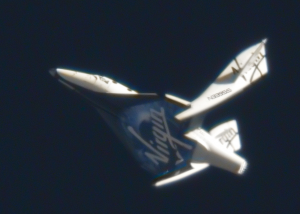
telescopic view of SS2 in free fall
on right, won’t enlarge (not enough pixels)
The space ship is taken to ~ 40 thousand feet before release, thus saving fuel.
White Knight with SS2 slung between the double fuselage
2 Space X (Elon Musk) and the
Dragon Capsule and Falcon 9 (their reusable rocket) are at present ferrying cargo to the ISS
Photo (right) of Dragon capsule 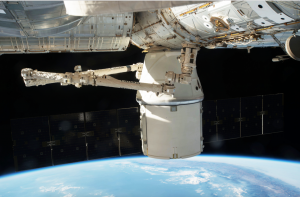
docked at the ISS last September, the capsule can then be sent back to Earth (unmanned) and contents survive splashdown and can be retrieved.
Photo (right) of Falcon 9 rocket less payload successfully landed on barge (off Florida coast) See youtube “Space X Falcon”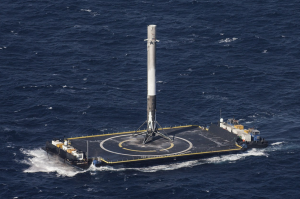
3. NASA‘s newest: the ORION crew this capsule can carry six crew and is currently being tested. 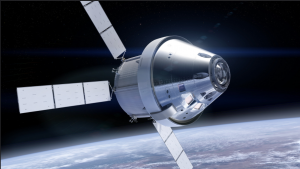
this capsule will be the basic element in future Moon or Mars exploration. First manned flight around Earth to be this year.
Finally we spoke about NEW HORIZONS (in KUIPER BELT) final target, the KBO object MU69 which will be reached New Year’s Day 2019. (no photograph available yet)
Good stargazing,
Martin


